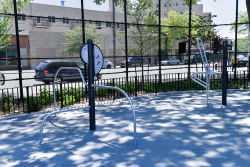Glenwood Playground
Glenwood Playground
Glenwood Playground, located at the intersection of Ralph Avenue and Farragut Road, is named for nearby Glenwood Road. Originally named Avenue G, Glenwood Road was constructed in 1902 as part of the Brooklyn grid system. A local law of 1926 renamed the street with reference to the wooded land that it traversed.
In 1869, the New York State legislature appointed the supervisors of the towns of Flatbush, Flatlands, Gravesend, New Lots, and New Utrecht to the positions of commissioners. Their duty was to design a street system that extended the layout of the City of Brooklyn, then a small urban area directly across the East River from New York City. The State rejected all but the most stringently conforming grid plans, hoping to ensure that the five towns would meld seamlessly into the City of Brooklyn when and if consolidation occurred.
The grid system was desirable for commercial reasons, as it would ease transportation and maximize the use of available land for residential purposes. The commissioners’ extensive calculations demonstrated that the 23,336 acres that comprised the five towns could house up to 1,956,836 people if each block would be 700 by 200 feet, streets 60 feet across and avenues 80 feet across. Exactly 4,992 blocks could be created in this fashion. Each city block would include 56 lots with seven residents per lot. The layout of Brooklyn ultimately reflected both these grid plans and the alternative vision of urban planner Frederick Law Olmsted (1822-1903). With Prospect Park as its centerpiece, his plan of parks and parkways was meant to allow the old towns to retain their distinction and preserve as much of the pastoral atmosphere as possible in the midst of suburbanization.
The towns of Flatbush, Gravesend, and New Utrecht were annexed to the City of Brooklyn in 1894. In 1898, the City of Brooklyn became one of the five boroughs of consolidated New York City. Though it saw its population climb to 2,465,326 in 2000, the land from the five grid towns has never had to house as many people as the commissioners had planned to accommodate.
Parks acquired Glenwood Playground in 1951 through a local law. The playground, surrounded by chain link fencing, contains many benches and London planetrees (Platanus x acerifolia). The playground offers a swing set in addition to handball courts and colorful play equipment paid for with $115,350 from City Councilman Lloyd Henry in 1997. Additional improvements came from $15,000 in requirement contracts to fix the slate roof of the playground’s public restroom. A unique feature of this playground is the wading-pool, one of the few remaining in City playgrounds.
Check out your park's Vital Signs
Clean & Safe
Green & Resilient
Empowered & Engaged Users
Share your feedback or learn more about how this park is part of a
Vital Park System








